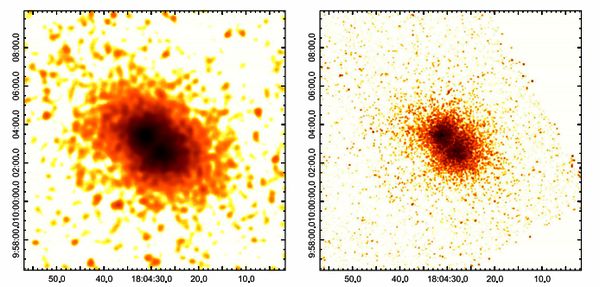In Λ cold dark matter (ΛCDM) cosmology, structures form hierarchically. Clusters of galaxies are the largest gravitational bound systems and their mass functions are very sensitive to cosmological parameters, so they can be used as sensitive probes for cosmology. To do this, astronomers need to measure their masses to a high accuracy, which ultimately limit the constraining power of clusters on cosmology.
Astronomers studied a merging cluster, PLCK G036.7+14.9, from the Chandra-Planck Legacy Program, which aims at obtaining the mass function of a low redshift (z<0.35) sample of the Planck early Sunyaev-Zeldovich (ESZ) cluster sample to constrain cosmological parameters. The high resolution X-ray observations of PLCK G036.7+14.9 reveal two close yet clearly separated subcultures, G036N and G036S, which were not resolved by previous ROSAT, optical, or recent Planck observations. Spectral analysis confirms that the two subcultures are interacting.
Based on both subclusters' morphologies and surface brightness profiles beyond the interaction region, temperature variations in the core regions, as well as a simplified dynamical model, the astronomers argue that the merger should be at an early stage and largely along the line-of-sight. G036N hosts a small and moderately cool core, while G036S has at most a very weak cool core, and this difference is unlikely to be caused by the ongoing merger. G036N also hosts an unresolved radio source; if the radio source is extended, it might be heating the gas in G036N's core.

Figure 1. X-ray images(2.2 Mpc × 2.1 Mpc) of PLCK G036.7+14.9. North is up and east is to the left. Left: XMM-Newton EPIC (quiescent particle and residual soft proton) background subtracted and exposure corrected image in the 0.7–2.0 keV band, smoothed with a 15″ Gaussian kernel. Each pixel has a size of 2.52.5´. Thelarge scale X-ray emission is elongated in a northeast–southwest direction, suggesting that PLCK G036.7+14.9 may be undergoing a merger. Two subclusters, G036Nin the north and G036S in the south, were also resolved, although the separation between them is quite small(∼72″ = 193 kpc in projection). Outside the interaction region between the two subclusters, the morphologies of G036N and G036S do not deviate significantly from spherical symmetry. Right: Chandra 0.7–7.0 keV background subtracted and exposure corrected image, smoothed with a 3. 9 4 Gaussian kernel. The image is not binned; i.e., 1 pixel has a size of 0. 492 0. 492. The large scale X-ray emission exhibits the same behavior as XMM-Newton revealed, with more details of the two subclusters resolved. A point source is visible at the center of G036N, which is an AGN. A bow shaped gap(with an angle of ∼145°), is seen between G036N and G036S, another indication of interaction between G036N and G036S.
The Planck derived mass is higher than the X-ray measured mass of either subcluster, but lower than the X-ray measured mass of the whole cluster, due to the fact that Planck does not resolve PLCK G036.7+14.9 into subclusters and interprets it as a single cluster. This mass discrepancy could induce significant bias to the mass function if such previously unresolved systems are common in the Planck cluster sample. High resolution X-ray observations are necessary to identify the fraction of such systems and correct such a bias for the purpose of precision cosmological studies.
This paper is led by B. Zhang, whose PhD supervisors Dr. L. Ji in Purple Mountain observatory and Prof. X. Kong in University of Science and Technology of China, together with collaborators from Havard-Smithsonian Center of Astrophysics and other universities in United States, are all involved in this project.
The research work by B. Zhang, JI Li , etc. has been published in The Astrophysical Journal Volume 804 Number 2 . B.Zhang etal. 2015 ApJ 804 129 doi:10.1088/0004-637X/804/2/129
For more insight into the project see: http://iopscience.iop.org/0004-637X/804/2/129/
